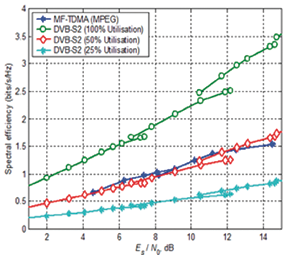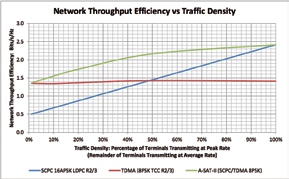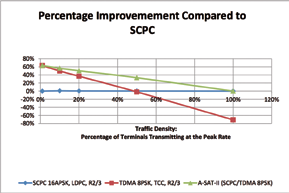Throughout the evolution of satellite communications, various technologies have been presented as best suited to the users’ needs.

In reality, the maturation of SCPC, SCPC DAMA, TDMA and MF-TDMA technologies have provided point solutions to specific needs. These needs have ranged from best possible power and bandwidth efficiency for fixed traffic loads (SCPC) to highly flexible bandwidth assignment (short-burst MF-TDMA), to priority and jitter free burst mode SCPC (BM-SCPC) among a large population of remote terminals.
This technique, called Adaptive Satellite Access Technology (A-SAT-II™), trades off the high power/bandwidth efficiency of DVB-S2 SCPC with the statistical multiplexing capability of MF-TDMA and jitter free BM-SCPC according to the instantaneous conditions being presented to the remote terminal.
Advantech Wireless has increased the flexibility and responsiveness of A-SAT™ with the introduction of A-SAT-II™. This next generation of Advantech Wireless’ A-SAT adds a third access scheme dubbed Burst Mode SCPC (BM-SCPC™). BM-SCPC provides highly responsive, low jitter, high throughput channels for critical applications, such as voice and tele-conferencing.
While designed for today’s satellites and VSAT networks, A-SAT-II is also developed for the emerging High Throughput Satellites (HTS) and to what degree they will change the overall VSAT landscape and how to take advantage of that change.
A-SAT-II Overview
1. The Basics of A-SAT-II
Modern bandwidth-on-demand satellite networks have provided broadband access to users previously unable to participate in the information age. These improvements have been made possible by the rapid evolution of affordable processing power. Such evolution was necessary to enable the use of short-burst MF-TDMA approaches.
Short burst MF-TDMA systems are optimized for flexibility and responsiveness to changing traffic demands among its users. As an example, such systems excel at addressing scenarios where the user rapidly switches from web browsing (infrequent, small transmissions of data) to sourcing streaming video (near-constant, high rate transmission). SCPC continuous carrier systems trade the above-described flexibility in favor of strong physical performance, a.k.a. power/bandwidth efficiency.

Figure 1. Spectral Efficiencies: MF-TDMA versus SCPC.
This physical performance arms system network designers with the ability to select between reduced operational costs (through increased bandwidth efficiency) and increased robustness of the communications link. The monthly operational costs of a typical satellite network is dominated (typically up to 65 percent of the recurring costs) by the price of the satellite space segment.
The physical layer power/bandwidth efficiency is, however, only one part of the picture. Continuous (SCPC) carriers are semi-permanently assigned to particular connections—any unused capacity is wasted. MF-TDMA allows sharing of the total system capacity among all connections according to instantaneous bandwidth needs. This results in multiplexing gains that can reach a factor of 4 for telephony and even higher values for interactive traffic. All else being equal, this outweighs the factor of 2 loss of physical layer efficiency sometimes experienced by MF-TDMA when compared to SCPC.
Among SCPC technologies, DVB-S2 is the best modulation and coding scheme available today. The results for DVB-S2 are shown in Figure 1 for varying degrees of actual utilization, from 100 percent (e.g., a constant rate video stream just filling the carrier) down to 25 percent (an optimistic value for Internet traffic). It can be seen that the SCPC carrier needs, on average, to be at least 50 percent full in order to perform better than the MF-TDMA. Therefore, with any substantial variability in traffic, MF-TDMA is the better choice.
In real life, the situation depends on the traffic statistics and communication link conditions. When the traffic is highly variable, the trade-off always comes out in favor of MF-TDMA. However, when the traffic demand is less variable, and/or when the satellite link conditions may degrade, it becomes attractive to use continuous carrier DVB-S2 SCPC.
The Advantech Wireless A-SAT terminals can support both MF-TDMA and DVB-S2 SCPC mode, allowing the dynamic transition from one mode to another without requiring any hardware changes at the remote site.
The Adaptive Satellite Access Technology architecture combines the best properties of the MF-TDMA and DVB-S2 SCPC approaches in a single architecture, which can adapt its operation in real time to the needs of individual terminals, their current link conditions and of the overall network.

Figure 2: Network Throughput Efficiency versus Inbound Traffic Density
In parallel with this, A-SAT provides on-the-fly re-configuration of the system frequency plan, so that bandwidth can be moved between MF-TDMA and continuous carrier operation.
The objective is to use the most appropriate combination of access schemes for any terminal at any time: MF-TDMA will be used when the traffic demand is low or for a highly variable component of a total demand, while continuous DVB-S2 carriers will be used for a more constant or minimally variable traffic demand.
2. Enhancing A-SAT™ with Burst Mode SCPC (A-SAT-II)
From the information above, the responsiveness of MF-TDMA has many benefits to the user. This is especially true for real time applications, such as voice and tele-conferencing.
One shortcoming of regular MF-TDMA may be the possibility of jitter in the transmission. Applications such as voice are sensitive to jitter and impairments on the transmission are readily perceived by the user.
Another possible shortcoming of MF-TDMA is the shared nature of the resource. This is generally of great benefit when the transmission bit rates are low and there is unused capacity on the MF-TDMA carriers that can be assigned to different users. However, high priority users may experience reduced transmission rates due to congestion or simply the transmission requirements of the application exceed the normal capacity assigned to that user.
BM-SCPC overcomes these issues by incorporating a priority scheme into the typical MF-TDMA assignment algorithm. High priority users are identified at setup time by the network operator. When the high priority user requests capacity for an application such as voice, the Network Management System (NMS) identifies its priority status. If necessary the NMS will shed assignments to lower priority users in order to fulfill the request of the high priority user. At the end of that application session (i.e. end of the voice call) the NMS restores the typical assignments to all users. The capacity of the assignment can be up to the full capacity of the MF-TDMA carrier.
3. The Benefits of A-SAT-II™

Figure 3: Comparison of Access Techniques
Carrier Access Efficiencies
As shown earlier in Figure 1, both DVB-S2 SCPC and MF-TDMA have varying carrier access efficiency performance depending on the degree of occupancy of the carrier. Expressed as bits/s/Hz, the carrier access performance is the throughput achieved in available bandwidth. SCPC is highly efficient if the carrier is fully utilized, whereas MF-TDMA is more efficient than SCPC when the carrier utilization is 50 percent or less.
Network Throughput Efficiency
A key element in the A-SAT performance is the network throughput efficiency experienced when multiple sources of traffic can share a common MF-TDMA carrier. We define the throughput efficiency as a measurement of access performance (bits/s/Hz) in real networks with mixed traffic sources. It compares network throughput to required overall bandwidth when statistical multiplexing of incoming traffic is considered.
Figure 2 depicts the access performance of MF-TDMA, SCPC and A-SAT-II techniques as a function of network traffic density. The following are definitions of the terms used in figure 2 below:
Network Throughput Efficiency: Ratio of inbound network throughput to the occupied bandwidth at various traffic densities.
Traffic Density: Percentage of terminal population operating at peak data rate. Remaining terminals are operating at the average data rate.
Average Data Rate: Data rate assumed per terminal averaged over extended time. In this example, average data rate is assumed to be 20 percent of peak data rate.
Another way of showing the performance of the A-SAT-II technology is to compare the performance as a percentage of the SCPC-only scenario. The figure at the top of the next column (Figure 3) depicts this concept.
The MF-TDMA approach is not as efficient as SCPC when the traffic density exceeds 50 percent, while the A-SAT-II performance exceeds that of SCPC— at all traffic densities except 100% when A-SAT is equivalent to SCPC.
The Advantech Wireless second generation Advanced Satellite Access Technology (A-SAT-II) provides the satellite operator with a superior means of designing his network to efficiently meet all varying traffic types. Whether the traffic is bursty Internet exchanges or large file transfers, the A-SAT-II access techniques ensures the most efficient transport. This minimizes the operating expense (satellite resource lease) while providing a flexible approach that will adapt to changing traffic patterns and priority.

Mr. John Landovskis has worked in the space industry for more than 30 years. He has been involved in TDMA product development since 1981 first with Spar Aerospace and then with Comtel and ComStream. Mr. Landovskis was instrumental with his team in the development of the DVB-RCS standard. He assumed increasingly more senior positions and was the CTO for EMS Satellite Networks when it was acquired by Advantech Wireless. At Advantech Wireless Mr. Landovskis has led the development of numerous innovative products. He is Member of the Order of Engineers of Quebec and holds a Bachelor of Electrical Engineering and Post Graduate courses in Management, from McGill University in Montreal.

